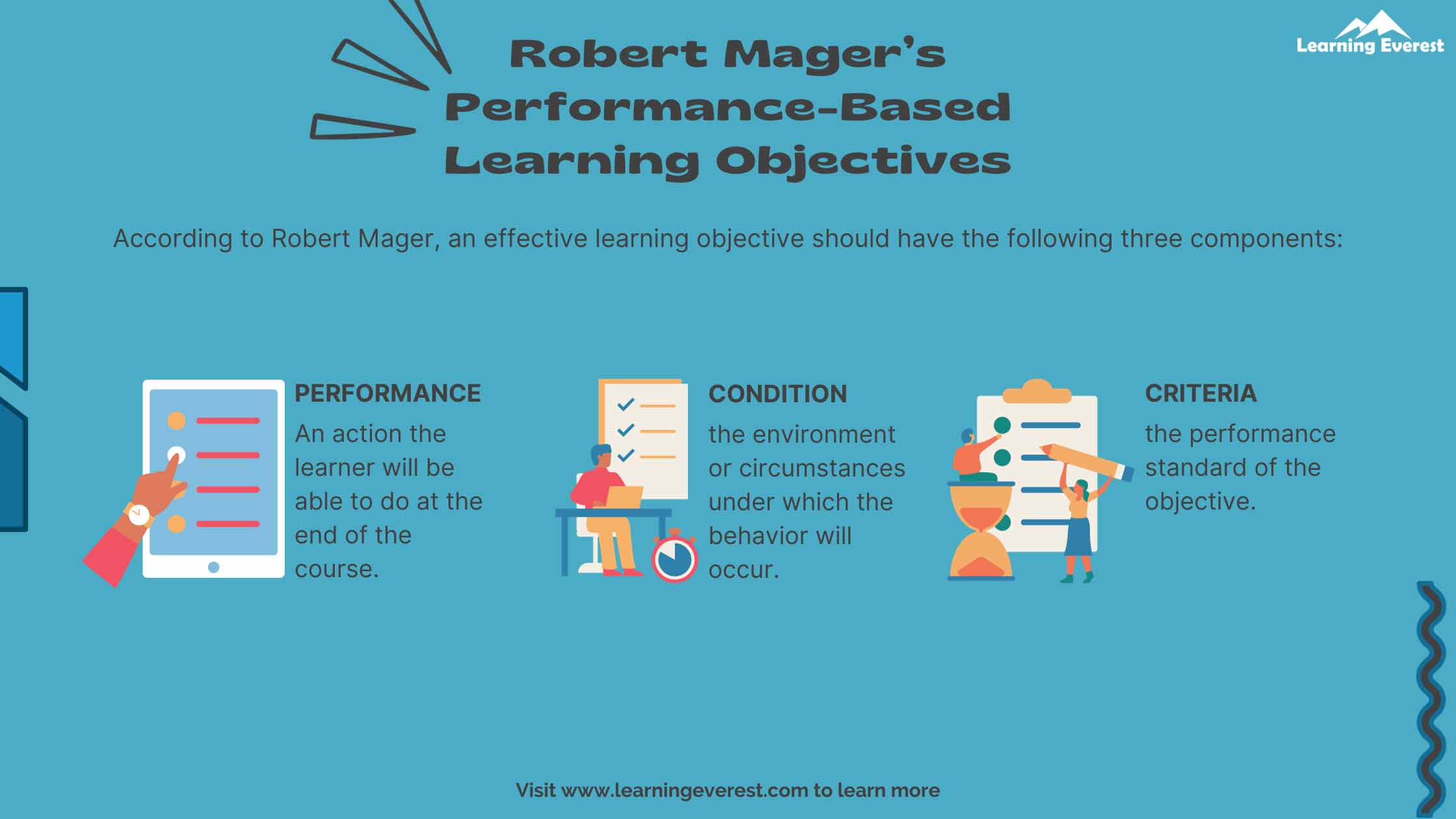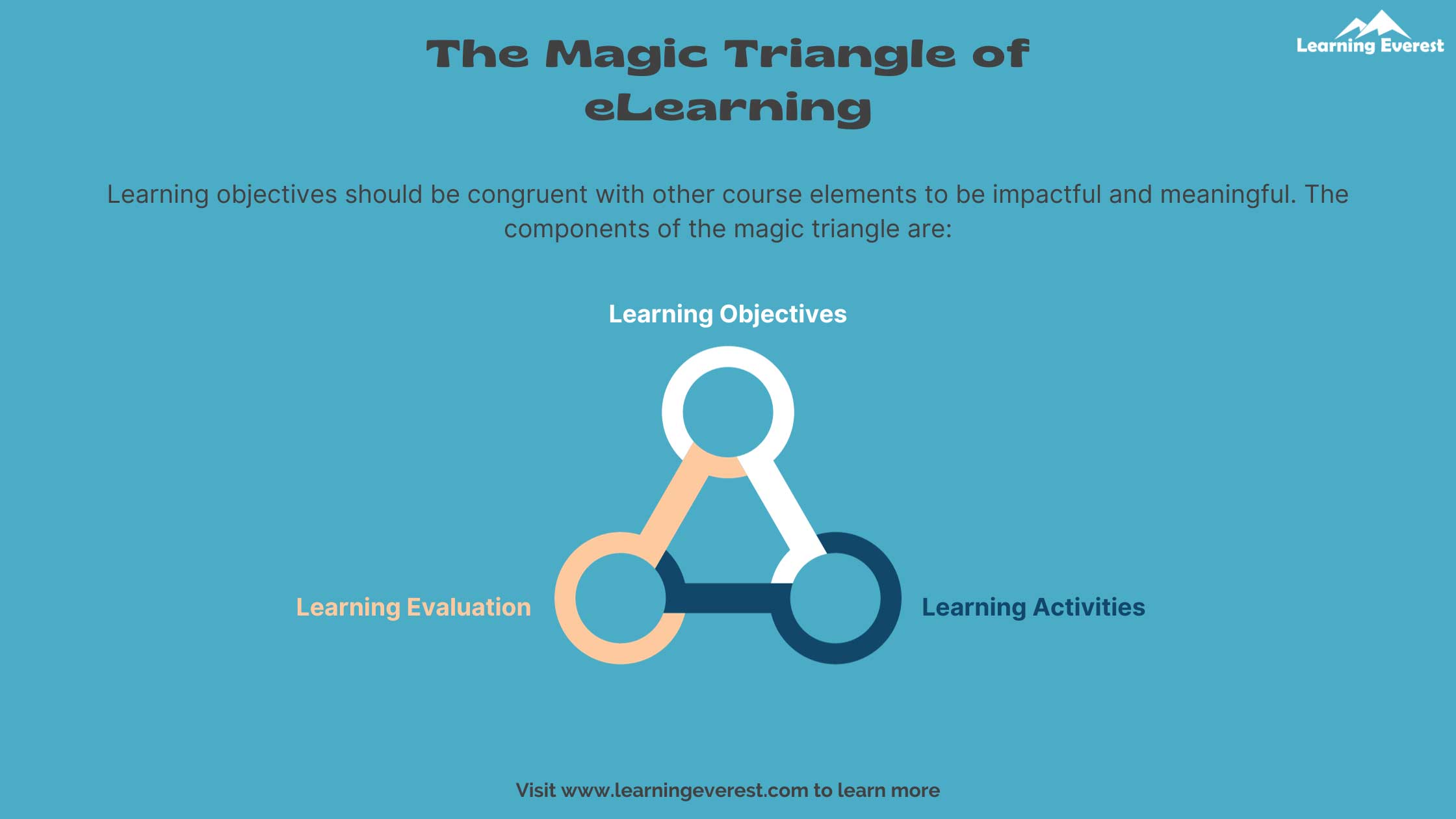Educational programs are incomplete without learning objectives. They shape the structure of courses, key assessment areas, and learner evaluation. Thus, competent instructional designers and L&D professionals are skilled at transforming curriculums into concise and meaningful targets.
Table of Contents
- Learning Objectives Deconstructed
- Learning Objective Frameworks
- The Importance of Learning Objectives According to Robert Mager
- The Magic Triangle of Learning Objectives, Learning Activities, and Evaluation
- Conclusion
- Infographics
- Knowledge Check!
- Frequently Asked Questions (FAQs)
- What are some examples of learning objectives?
- What is a well-written learning objective?
- How do you write a learning objective for a lesson plan?
- What are the 6 levels of Bloom’s Taxonomy?
- What are Robert Mager’s Performance-Based Objectives?
This article will break down the ever-reliable formula for writing learning objectives that both learners and instructors find easy to understand and follow.
Learning Objectives Deconstructed
Learning objectives are a set of statements that list the behavioral or cognitive changes that a course intends to produce in its learners. These changes are, thus, explicit indicators that a training fulfilled its purpose.
To start off, effective learning objectives have three fundamental characteristics that set them apart from ineffective ones:
- They are actionable
- They are measurable
- They are specific
Being actionable means that a learning objective produces a certain behavior or thought or has applicability. A measurable objective clearly states what kind or degree of change counts as significant. Specificity refers to a clearly defined outcome.
Accordingly, every learning objective should have the following components:
- An action verb that can be measured
- A behavioral outcome
- A specific area of applicability for every objective
To illustrate, let us compare the following two learning objectives:
- By the end of this course, the learner will be able to figure out and write the learning objectives of a curriculum
- By the end of this course, the learner will be able to write precise and measurable learning objectives for e-learning courses
Out of these examples, the second one contains a singular action and objective and lends a clearer picture of the behavioral change that will occur in a learner. On the other hand, the first example lists two verbs and says little about the quality of behavior the learner will produce by the end. “Curriculum” is also a very broad term and is not used interchangeably with “course” or “training program” often.
Based on the components mentioned above, a more formulaic representation of learning objectives would, thus, be:
(One measurable action verb) + (one outcome) + (one specific area of applicability)
Additionally, learning objectives define changes in three domains, namely the cognitive (knowledge and knowing), psychomotor (performing or doing), and affective (feelings and emotions). Thus, when learning objectives talk about changes in learner behavior, it does not only include overt behavior, but also internal states and mental structures.
Learning Objective Frameworks
In the L&D sphere, two frameworks are famously used to guide the learning objectives of courses. These are Robert Mager’s performance-based learning objectives and Bloom’s Taxonomy. Depending on the course type and instructional designer’s preferences, these frameworks can be used together or separately.
1. Robert Mager’s Performance-Based Learning Objectives
Mager proposed a framework for writing learning objectives that listed three features. These features are:
- Performance – an action the learner will be able to do at the end of the course. A verb expresses this aspect of the learning object.
- Condition – the environment or circumstances under which the behavior will occur. A condition is not compulsory but is useful when learning objectives occur under varied circumstances.
- Criteria – criteria is the performance standard of the objective. For example, “by the end of this course, the learner will be able to list the 12 steps of addiction recovery.”
Performance-based objectives are a part of a more comprehensive instructional design approach Mager proposed. This approach is called criterion-referenced instruction and has 4 steps:
- Task analysis
- Performance objectives
- Criterion-referenced testing and evaluation of skills needed and developed as a result of course completion
- Development of modules

Robert Mager’s Performance-Based Learning Objectives
2. Bloom’s Taxonomy
Bloom’s taxonomy divides learning objectives in a hierarchy based on the complexity of the cognitive processes required to perform them. Thus, when following Bloom’s taxonomy, instructional designers should be careful of the learning objectives and courseware sequence. Objectives that require simpler cognitive involvement should come before the complex ones.
The taxonomy that is followed now is a revised version of the original edition and has 6 cognitive levels represented by verbs. These levels are:
- Remember – this stage consists of building familiarity with factual knowledge of the topic and the objective is to remember and recall this information effectively.
- Understand – in this stage, the learner delves deeper into the subject matter and develops a more personalized understanding of concepts and components.
- Apply – this stage deals with the direct practical application or performance of skills.
- Analyze – objectives of this cognitive level require learners to manipulate and dissect the information by themselves to discover and explore connections and comparisons.
- Evaluate – evaluating information entails engaging with the information independently to form unique judgments and make decisions based on criteria and standards.
- Create – at the creation level, learners use what they have learned to form something new and original.
Both frameworks have their own strengths and weaknesses. While Bloom’s taxonomy makes it easy to determine things like target audiences, the complexity of learning objectives, and the most efficient sequence to follow, Mager’s objectives highlight the importance of being extremely specific by adding conditions and criteria. Thus, these two approaches can be used harmoniously to write rich and detailed learning outcomes.
The Importance of Learning Objectives According to Robert Mager
Mager’s approach to writing learning outcomes comes from his book titled “Preparing Instructional Objectives”. In this book, he outlines why stating learning objectives is necessary. The three reasons he gives are:
- Learning objectives help determine the contents of the course and how to evaluate learners
- Learning objectives help gauge the extent of mastery a learner gains by taking the course
- Lastly, learning objectives help learners self-evaluate and be aware of the performance they’re expected to exhibit
The Magic Triangle of Learning Objectives, Learning Activities, and Evaluation
Another means to understand the importance of learning objectives is to think of its interaction with other key elements of courses as a magic triangle. These elements are learning activities and learner evaluation.
When the learning objectives are congruent with the learning activities learners participate in and the evaluation criteria, the curriculum feels meaningful to learners and produces better learning outcomes.
On the other hand, when learners sense these three features are incongruent, they lose interest in the course and feel discouraged about the learning experience. To counter this, modern instructional design models, such as the Kirkpatrick model, follow a backwards approach. Course design begins with laying down the objectives and then building content around them for maximum relevance.

The Magic Triangle of eLearning
Conclusion
Writing learning objectives requires care and skill. Well-written objectives can substantiate courses, shape evaluations, and articulate the course’s direction eloquently to learners. They can also develop a common language for instructors and make communication between them easier.
Infographics

A Formula for Writing Learning Objectives
Knowledge Check!
Frequently Asked Questions (FAQs)
What are some examples of learning objectives?
An example of a learning objective is:
“By the end of this course, the learner will be able to write precise and measurable learning objectives for e-learning courses.”
What is a well-written learning objective?
Effective learning objectives have three fundamental characteristics that set them apart from ineffective ones:
- They are actionable
- They are measurable
- They are specific
Accordingly, every learning objective should have the following components:
- An action verb that can be measured
- A behavioral outcome
- A specific area of applicability for every objective
How do you write a learning objective for a lesson plan?
Learning objectives for a lesson plan can be written by following this formula:
(One measurable action verb) + (one outcome) + (one specific area of applicability)
For e.g., “by the end of this course, the learner will be able to list the 12 steps of addiction recovery.”
What are the 6 levels of Bloom’s Taxonomy?
The 6 levels are remember, understand, apply, analyze, evaluate, and create.
What are Robert Mager’s Performance-Based Objectives?
Mager proposed a framework for writing learning objectives that listed three features. These features are:
- Performance – an action the learner will be able to do at the end of the course. This aspect of the learning object is expressed by a verb.
- Condition – the environment or circumstances under which the behavior will occur. A condition is not compulsory but is useful when learning objectives occur under varied circumstances.
- Criteria – criteria is the performance standard of the objective.






